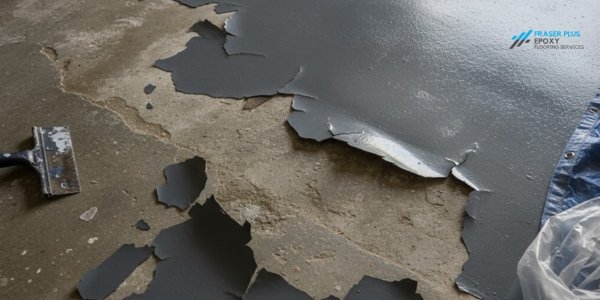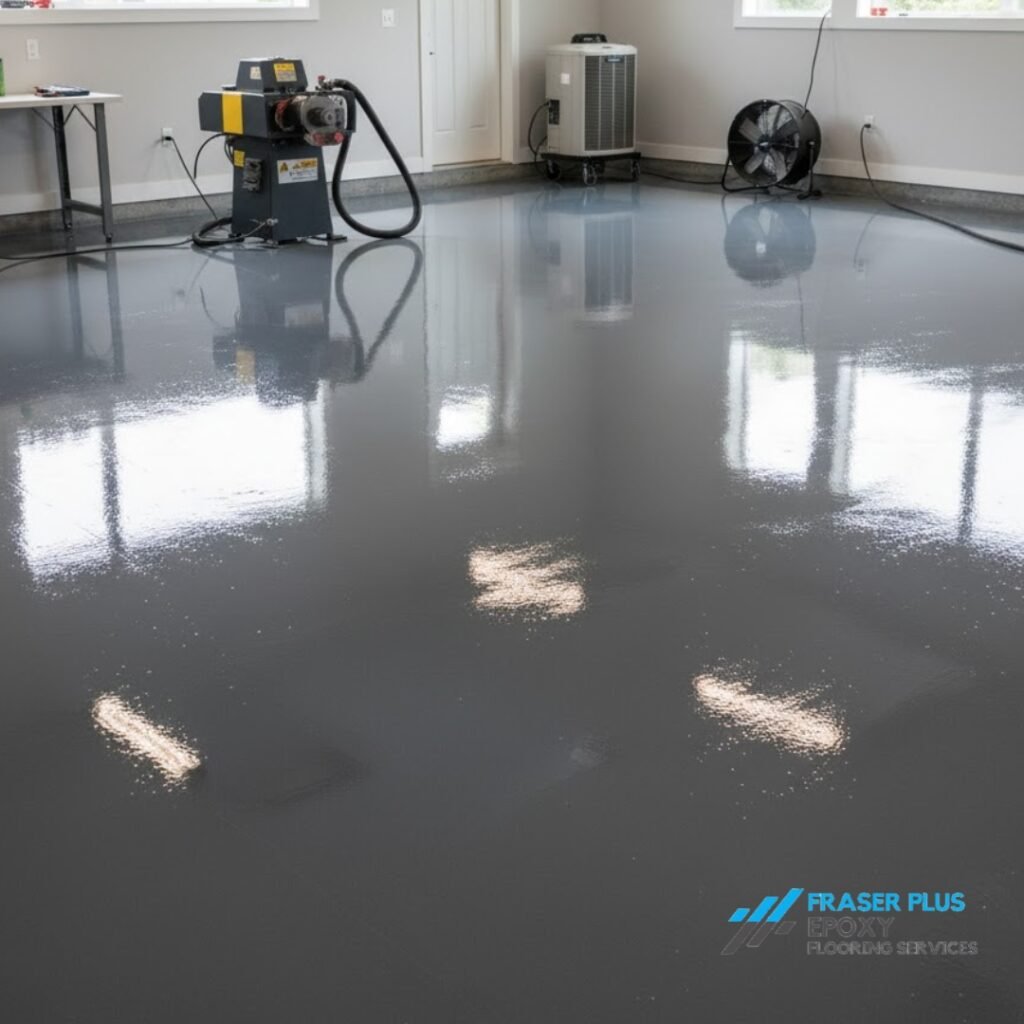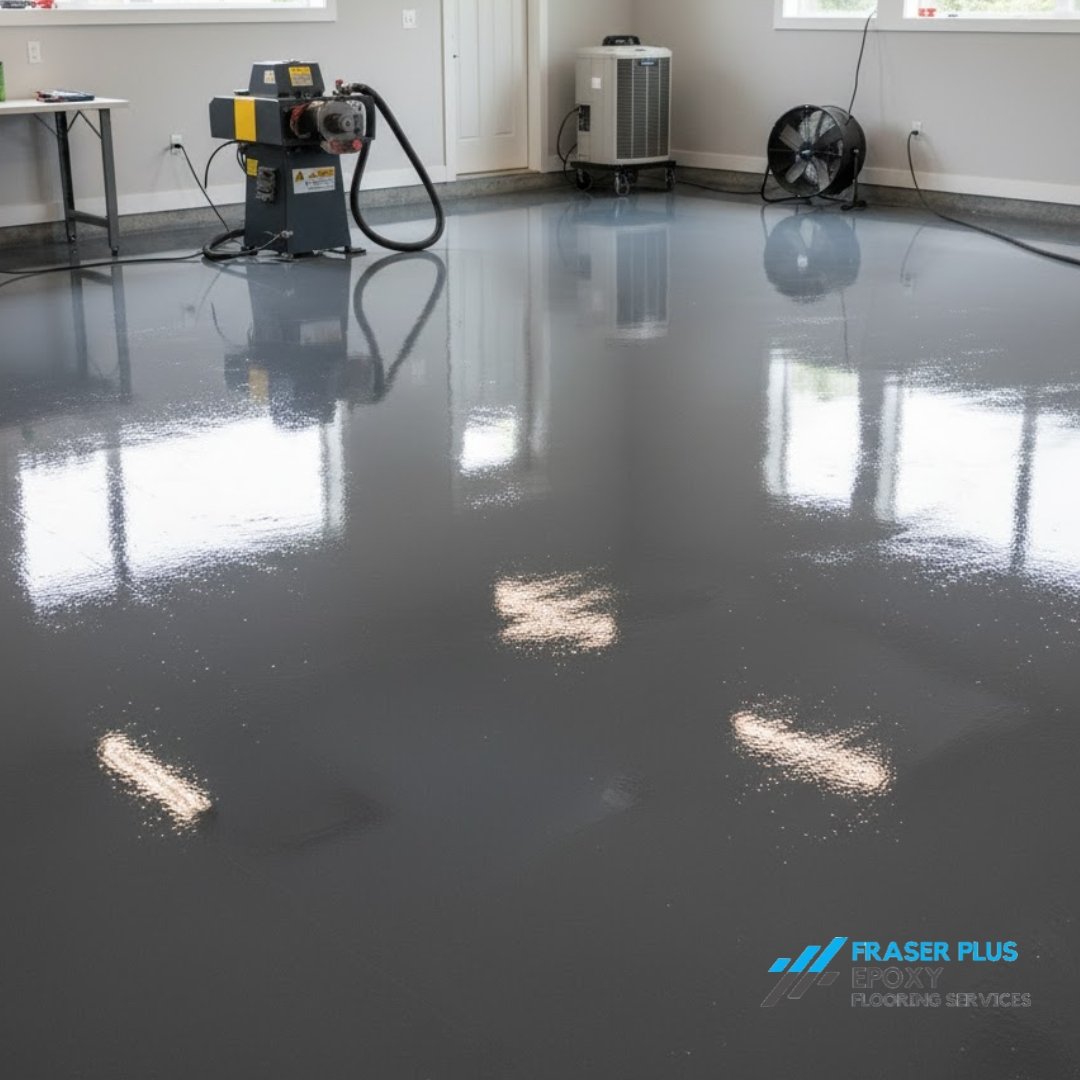The Science Behind Epoxy Floor Failures: Why Good Coatings Go Bad
Understanding why epoxy floors peel and chip requires grasping the science of adhesion and the environmental factors that can destroy even properly applied coatings. Epoxy floor failures almost never happen randomly—they follow predictable patterns that experienced contractors have learned to anticipate and prevent.
The most fundamental cause of epoxy failure is poor adhesion between the coating and concrete substrate. Think of it like trying to paint over a dusty surface—no matter how expensive your paint, it won’t stick properly if the foundation isn’t prepared correctly. Concrete surfaces contain microscopic dust, residual oils from construction, weak surface particles called “laitance,” and sometimes previous coatings or sealers that create barriers to proper bonding.
Moisture represents the most destructive enemy of epoxy floors, particularly in Vancouver’s climate. When water vapor rises through concrete pores (hydrostatic pressure) or condenses beneath the coating due to temperature changes, it creates pressure that literally pushes the epoxy away from the concrete. This moisture can come from below-grade sources, inadequate concrete curing, cleaning activities, or even high humidity during the coating process.
Research shows that moisture-induced hydrostatic pressure is a leading cause of epoxy failure in concrete floors, underscoring the importance of moisture testing before installation.
Temperature and humidity fluctuations during installation and curing create additional failure risks. Epoxy coatings must cure within specific environmental parameters to develop full strength and adhesion. Vancouver’s unpredictable weather means installation windows can close suddenly, and attempting to rush the process often results in coating systems that appear acceptable initially but fail within months as they never achieved proper molecular crosslinking.
Chemical contamination from oils, cleaning products, de-icing salts, and even concrete additives can prevent proper adhesion even when surfaces appear clean. These contaminants might not be visible but create chemical barriers that no amount of coating thickness can overcome.
Vancouver’s Climate Challenge: Why Our Weather Makes Epoxy Installations Tricky
Vancouver’s Pacific Northwest climate creates a perfect storm of conditions that challenge epoxy floor installations, making expert knowledge and proper techniques absolutely essential for long-term success. Our region’s combination of high rainfall, humidity fluctuations, and temperature swings requires specialized approaches that many contractors from other climates simply don’t understand.
Our average annual rainfall of over 1,200mm means concrete slabs, particularly in garages and basements, are constantly dealing with moisture infiltration. Even properly sealed concrete can absorb moisture through microscopic pores, and this moisture must be allowed to escape or be properly managed during epoxy installation. When moisture becomes trapped beneath a coating, it creates hydrostatic pressure that causes blistering, bubbling, and eventual delamination.
Humidity fluctuations throughout the year create additional challenges. Summer months with higher humidity can slow epoxy curing and create surface defects, while winter heating systems can cause rapid moisture evaporation that leads to incomplete coating adhesion. The ideal installation window in Vancouver often requires artificial climate control using dehumidifiers, heaters, or ventilation systems.
Our mild temperatures might seem ideal for coating work, but the reality is more complex. Vancouver’s temperature swings, combined with our coastal humidity, create conditions where surface preparation becomes critical. Concrete surfaces can appear dry while containing significant subsurface moisture that won’t be revealed until the epoxy is applied and begins failing.
The coastal salt air factor adds another layer of complexity. Properties near the ocean or those exposed to road salt during winter months must contend with chloride contamination that can chemically attack both concrete and epoxy coatings over time. This requires specific surface preparation techniques and coating systems designed to resist chemical degradation.
Diagnosing Your Epoxy Problems: Repair vs. Complete Replacement

When faced with peeling, chipping, or flaking epoxy, the critical decision becomes whether to attempt repairs or invest in complete system replacement. Making the right choice depends on understanding the extent of damage, the underlying causes, and the long-term performance expectations for your space.
Minor surface damage typically includes small chips from dropped tools, localized wear patterns from heavy foot traffic, or surface scratches that don’t penetrate to the concrete. These issues can often be successfully repaired using patching compounds, spot re-coating techniques, or protective topcoat applications. The key is ensuring that the underlying adhesion remains sound and that the damage hasn’t allowed moisture infiltration.
Moderate delamination patterns include larger areas of peeling, bubbling sections, or coating that lifts easily when probed with a putty knife. These problems usually indicate either moisture issues or adhesion failures during installation. Repair success depends on identifying and correcting the root cause—simply patching over failed areas without addressing underlying moisture or preparation issues leads to recurring problems.
Extensive system failure involves widespread peeling, coating that separates in large sheets, or areas where the concrete substrate appears damaged or contaminated. These situations typically require complete removal and reinstallation, as the failure patterns indicate fundamental problems with either the substrate condition or installation process.
The diagnostic process involves moisture testing the concrete, checking for oil or chemical contamination, evaluating the remaining coating adhesion, and determining whether the substrate requires repair. Professional evaluation can reveal whether problems stem from installation errors, environmental factors, or normal wear and tear—information that’s crucial for making cost-effective decisions.
Cost-benefit analysis considerations: Repairs typically cost 30-50% of full replacement but may only provide 2-3 years of additional service if underlying problems aren’t corrected. Complete reinstallation costs more upfront but delivers 15-20 year performance when done properly with modern materials and techniques.
Professional Solutions: How Fraser Plus Epoxy Prevents and Fixes Floor Failures
The difference between epoxy installations that thrive for decades and those that fail within years often comes down to the expertise, equipment, and systematic approach used during installation and repair. Fraser Plus Epoxy has developed Vancouver-specific protocols that address our unique climate challenges while ensuring long-term coating performance.
Our surface preparation process begins with comprehensive concrete evaluation including moisture testing, contamination assessment, and structural analysis to identify any conditions that could compromise long-term performance. We use professional diamond grinding equipment to remove surface contaminants, create proper surface profile for coating adhesion, and eliminate the weak surface layer that causes many adhesion failures.
Environmental controls during installation eliminate weather-related failures. We use professional dehumidifiers, heaters, and ventilation systems to maintain ideal temperature and humidity conditions throughout the coating process. This controlled environment approach ensures proper cure development regardless of Vancouver’s unpredictable weather patterns.
Quality control measures distinguish professional installations from basic coating applications. We perform adhesion pull tests on sample areas to verify coating bond strength before full application. Multiple thin coats are applied rather than single thick applications, ensuring better adhesion and flexibility. Each coat is visually inspected and tested before subsequent layers are applied.
Repair strategies for existing damage depend on proper diagnosis and root cause correction. Minor chips and scratches can be successfully patched using color-matched repair compounds and localized re-coating techniques. More extensive damage requires partial or complete coating removal, substrate re-preparation, and system reinstallation using improved materials and techniques.
Our warranty and follow-up program provides peace of mind for Vancouver homeowners and businesses. We offer comprehensive warranties covering both material performance and installation workmanship, backed by regular follow-up inspections and maintenance recommendations. This ongoing relationship ensures optimal floor performance throughout its service life while addressing any emerging issues before they become major problems.
Prevention Strategies: Keeping Your New Epoxy Floor Perfect for Years
Once you’ve invested in professional epoxy floor installation or repair, implementing proper maintenance and prevention strategies becomes essential for protecting that investment and maximizing floor lifespan. The good news is that properly installed epoxy floors require minimal maintenance while delivering decades of reliable performance when basic prevention principles are followed.
Daily and weekly maintenance routines focus on preventing damage rather than repairing it. Regular sweeping or dust mopping removes abrasive particles that can gradually wear coating surfaces. Prompt cleanup of spills, particularly acidic substances like battery acid or certain cleaning chemicals, prevents chemical etching that can damage epoxy surfaces. Using walk-off mats at entry points dramatically reduces the introduction of moisture, dirt, and abrasive materials.
Seasonal maintenance considerations address Vancouver’s specific climate challenges. Winter preparation includes inspecting door seals and drainage systems to prevent water infiltration. Spring cleaning should include thorough washing with pH-neutral cleaners to remove salt residue and winter contamination. Summer humidity control helps prevent condensation issues that can affect coating integrity over time.
Traffic management and protection strategies extend floor life significantly. Using furniture pads under heavy equipment, implementing proper snow and ice removal procedures to minimize chemical exposure, and avoiding dragging heavy objects across floors prevents mechanical damage that can compromise coating integrity. For commercial applications, establishing traffic patterns and protective protocols maintains floor appearance and performance.
Early problem detection and response prevents minor issues from becoming major repairs. Monthly visual inspections can identify small chips, scratches, or areas of wear before they allow moisture infiltration or expand into larger problems. Prompt attention to drainage issues, ventilation problems, or unusual wear patterns maintains optimal floor conditions.
Professional maintenance programs provide comprehensive protection for high-value installations. Fraser Plus Epoxy offers annual inspection and maintenance services that include deep cleaning, minor repair touchups, protective sealant applications, and condition assessments that identify potential problems before they require expensive corrections. This proactive approach typically extends floor life by 30-50% while maintaining optimal appearance and performance.
Making Smart Decisions: When to DIY vs. Call the Professionals
The abundance of DIY epoxy products and online tutorials can make floor repair seem like a weekend project, but understanding when to attempt repairs yourself versus calling professionals can save thousands of dollars and prevent recurring problems. The key is honestly assessing both the extent of damage and your ability to address the underlying causes that created the problem initially.
DIY-appropriate situations typically involve minor surface damage on floors that are otherwise performing well. Small chips from dropped tools, localized scratches that don’t penetrate to concrete, or worn areas smaller than a few square feet can often be successfully patched using high-quality repair kits. However, success requires proper surface preparation, compatible materials, and ideal environmental conditions during repair.
Professional intervention becomes necessary when damage indicates systemic problems like moisture infiltration, adhesion failure, or substrate contamination. Large areas of peeling, bubbling sections, or coatings that lift easily suggest underlying issues that DIY approaches cannot address. Attempting to patch over failing systems usually results in recurring problems and wasted money.
The hidden complexity factor often makes professional repair more cost-effective than initially apparent. Proper color matching, surface preparation, contamination removal, and environmental control during repair require specialized equipment and expertise. Professional repairs also include proper diagnosis of failure causes and implementation of prevention measures that DIY approaches typically cannot address.
Cost considerations and long-term value** favor professional solutions for anything beyond minor cosmetic damage. DIY repair kits cost $50-200 but often provide temporary fixes that fail within 1-2 years. Professional repairs cost more initially but typically include warranties and address root causes, providing lasting solutions that protect your overall flooring investment.
Fraser Plus Epoxy’s consultation approach helps Vancouver property owners make informed decisions about repair versus replacement. Our free damage assessments provide honest evaluations of repair feasibility, cost estimates for different approaches, and recommendations based on your specific situation and budget. We believe in building long-term relationships with clients, which means providing advice that serves your best interests rather than simply selling services.
Vancouver Epoxy Flooring Contractor | Fraser Plus Epoxy
Epoxy floor peeling and chipping aren’t inevitable—they’re usually preventable problems that result from installation errors, environmental challenges, or maintenance neglect. Understanding the specific causes in Vancouver’s climate empowers you to make smart decisions about repair, replacement, and prevention strategies that protect your flooring investment for decades. Whether you’re dealing with minor damage or extensive failure, professional diagnosis and proper solutions will save money and frustration compared to repeated DIY attempts or ignoring problems until they worsen.



